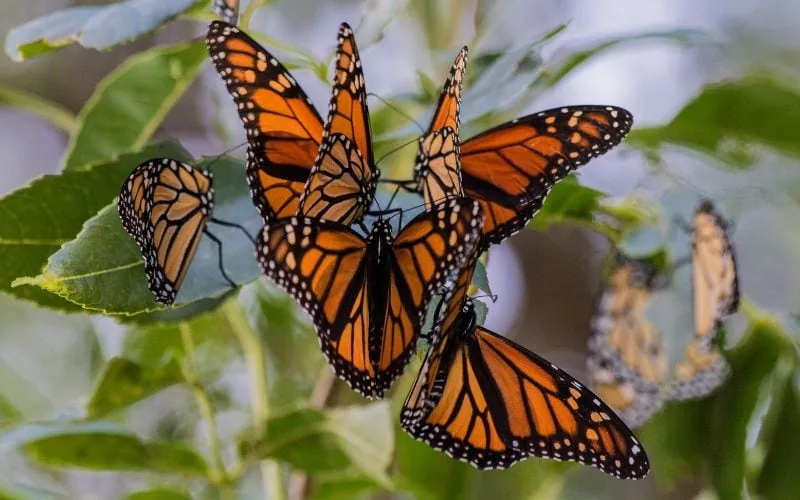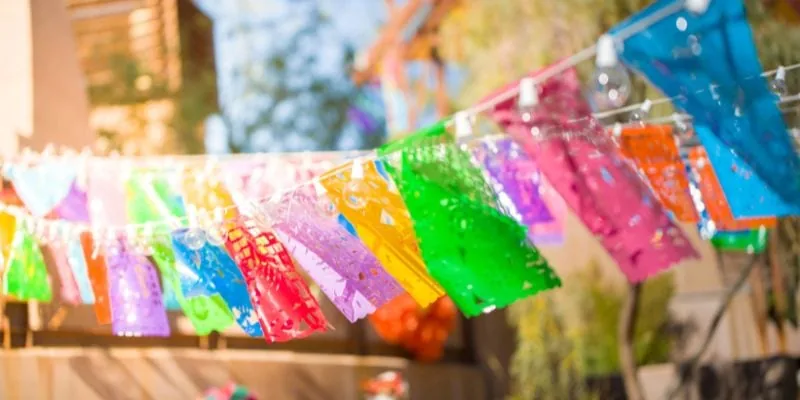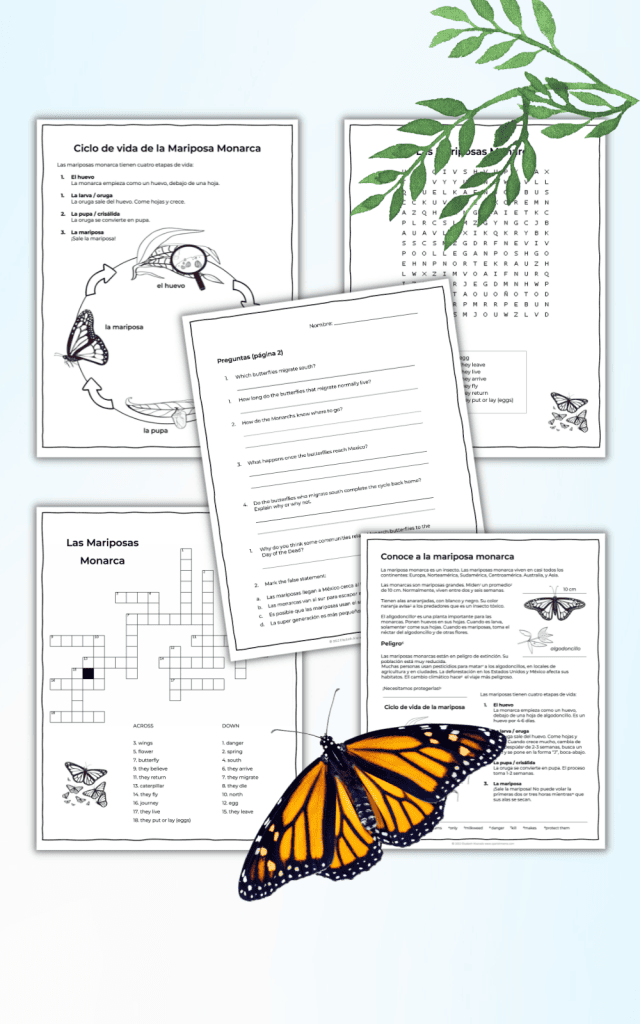Student Alternatives for Day of the Dead
Inside: Ideas for students who need a Día de Muertos alternative.
Most of us who teach Spanish love incorporating culture into our lesson plans, and Día de Muertos is no exception!
Imagery from Day of the Dead is increasingly common, both in stores and from movies like Coco, and Spanish class is a great way to offer meaningful context to the holiday.
Some teachers have student families who object to learning about Day of Dead. This might feel frustrating–students in social studies regularly learn about ancient traditions and other cultures, after all, and we know cultural competency is a vital skill.
Still, we have to work with our particular communities and contexts. Some reasons families might feel uncomfortable:
- They are uncomfortable with images of skulls and skeletons, or confuse it with Halloween.
(For some cultures, it’s hard to imagine approaching death as something other than taboo.) - They have heard or believe is involves communicating with spirits.
(Not every Spanish-speaker celebrates Day of the Dead, even in Mexico. Where I live in Peru, Nov. 1 and 2 are holidays, but with different customs. Evangelical Christians, for instance, don’t celebrate.) - Our lessons includes activities that feel like participation, such as decorations or hands-on crafts.
Even though most teachers feel like they are sharing culture in a sensitive and appropriate way, we don’t want to violate any students’ conscience. Below I have some quick ideas to help you offer an alternative.
Note: Another situation may be that you have.a student dealing with a recent loss. Many teachers share that doing something like an altar is a healing activity, but it’s very hard to know. I definitely recommend reading out to those students individually and/or offering accommodations.
Here’s what I have for you:
1. 5 Alternative Independent Lessons
2. 5 Alternative Crafts
3. Sample Letters to Families

Related: A Kid-Friendly Introduction to Day of the Dead
5 Ideas for Alternative Work
1. Learn About Monarch Butterflies
For some communities in Mexico, the annual arrival of the migratory monarch butterflies is part of their Day of the Dead celebrations. They are common in pre-Hispanic imagery as a symbol of the cycle of life and death, as in many other religions.
See my blog post on Monarch Butterflies and Day of the Dead for a bunch of printables and lesson ideas. They focus mainly on information about the butterflies, not the religious symbolism.
2. Write a Biography
Another common assignment is for students to simply write a biography of someone they knew or someone famous. If your students are creating altars, for example, you might offer that they can write an essay about the person instead. (This still honors the intent of keeping the persons’s memory alive– you could direct the student to focus on details such as what the person enjoyed and what was important to them.)
Here’s a list of 39 Famous Spanish Speakers.
3. Research José Guadalupe Posada
This is still adjacent to Day of the Dead, but focused on the biography of a historical figure. It takes a more informational approach to why we see images of skeletons– La Catrina, in particular– and is a pretty fascinating history.
- Read more about La Catrina.
- Free reading on Posada in Spanish, from TpT.
- Really well-done intro on YouTube:
4. Do a Compare/Contrast Activity
Because we really do want students who are culturally competent and able to thank you of other traditions, you could also create a compare and contrast assignment. This could be something like a Venn diagram, where they contrast Day of the Dead traditions with their own beliefs about the afterlife, or a comparison of Day of the Dead and a U.S. holiday like Memorial Day or Halloween.
5. Alternative Crafts
Especially if working with young students, there are relevant crafts you can do, while sticking with more neutral images. Papel Picado is a good option for any age.
- For older students, I found a free listening/interpretive project. It goes with a YouTube video in Spanish, with instructions on making Papel Picado.
- Here’s a short reading in English on Papel Picado.
See more craft ideas with videos here: Kid-Friendly Ideas for Day of the Dead.

Sample Letters to Families
Ideally, you can get ahead of any issues by sharing with families upfront. Below I put together some sample letters you can copy and paste to edit as needed.
Generic Letter for Middle/High School Classes:
Dear ______,
Next week we will learning about Day of the Dead: how it began, how different families celebrate, and what it means to them. In case this holiday is new to you, here’s some background info!
Día de Muertos is most famous as a Mexican holiday, but it’s observed in different forms throughout Latin America. In most places, it’s a mix of local indigenous beliefs and Catholic traditions. (This is why it’s celebrated on Nov. 1 and 2, All Souls Day and All Saints Day.)
Although Day of the Dead falls close to Halloween on the calendar, the two are not related. (It’s more similar to Memorial Day; a time to remember loved ones who have passed on.)
Most families celebrate Day of the Dead by creating an ofrenda in their homes. This is a space that reflects their own spiritual traditions and honors the memories of their relatives. Some people also use this time to visit local cemeteries, to clean and decorate their family member’s grave with flowers. Others attend church services or local parades.
Some families who are less religious celebrate Day of the Dead as more of a cultural tradition. For others, they believe that during this time the spirits of their loved ones come close to earth. Some of the decorations include things like sugar skulls and skeletons, which are meant to symbolize that death is a natural part of life.
Our goal is to learn what this holiday means to the people that celebrate it, and how different communities think about life, death, and the afterlife.
We always want to deepen our cultural understanding of different places where Spanish is spoken! I hope this is helpful and please reach out to me with any questions.
___________
Letter for Elementary Classes:
Dear ________,
Next week we will be learning about Day of the Dead in Spanish class. In case this holiday is new to you, I just wanted to share some quick background info!
Day of the Dead is celebrated in some Spanish-speaking places— most famously in Mexico. For those that celebrate it, it’s a special time for families to keep the memories of their loved ones alive.
In those cultures, candy and decorations made out of things like skulls are not meant to be scary, as we might see in holidays like Halloween. Rather, people use those symbols to remember that we don’t have to be afraid of death and can focus on our happy memories of people we love.
Day of the Dead is colorful day, and a lot of fun for the kids who celebrate it in their communities. In class, we will be learning about what their families do, in a kid-friendly way. This includes making some crafts (_______________) and watching a short video showing _______________.
Please reach out to me with any questions you might have!
___________________
Permission Slip for Day of the Dead Movie:
Part of Spanish class is learning about the cultures and places that speak Spanish. With Day of the Dead coming up, we will be watching the movie _________ (PG).
Day of the Dead is a holiday in some parts of Latin America, celebrated Nov. 1 and 2. It’s a colorful time for families to remember loved ones and honor their memories.
The movie does touch on themes like relatives who have passed on, and how some cultures imagine the afterlife. As always, our goal is to learn about different traditions around the world, and what life is like in other places. This is a great way for students to connect to the Spanish language.
Please feel free to reach out to me if you feel you need any more information!
I, _________________, give permission for my child, ______________, to watch _________.
I prefer that ______________ (child’s name) be given an alternate activity during the movie.
Permission Slip for Day of the Dead Project:
For some families, asking students to do a hands-on project feels like asking them to participate in a holiday. If you think you might have students that fall into this category, it may be best to send out a permission slip.
Dear _______________,
Part of Spanish class is learning about the cultures and places that speak Spanish. We are about to begin learning about Day of the Dead, which celebrated is many parts of Latin America on Nov. 1 and 2.
Day of the Dead is It’s a time to remember loved ones and honor their memories. Most families celebrate by creating an ofrenda in their homes. This is a space that reflects their own spiritual traditions and honors the memories of their relatives.
In class, each student will be asked to choose someone they would like to honor and remember. We will be creating ofrendas as a special project to help us understand how some people celebrate this holiday.
As always, our goal is to learn about different cultures and how they see the world. This is meant to be a special project to help the students connect to another culture, while comparing and contrasting it with their own personal beliefs.
I understand that every family has their own traditions. If you prefer an alternative to this project, your student is welcome to:
- Research and write a biography on a famous Spanish-speaker
- Write an essay explaining what an ofrenda is and what each of the elements mean.
I prefer that ______________ (child’s name) be given an alternate activity.
Please feel free to reach out to me if you feel you need any more information!








Thank you!
It is such a hard thing for other people to understand that we are not teaching them a religion but an aspect of the culture. The permission slips were extremely useful too.
Muchas gracias